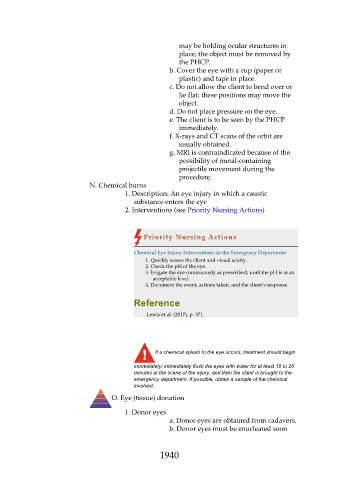Page 1940 - Saunders Comprehensive Review For NCLEX-RN
P. 1940
may be holding ocular structures in
place; the object must be removed by
the PHCP.
b. Cover the eye with a cup (paper or
plastic) and tape in place.
c. Do not allow the client to bend over or
lie flat; these positions may move the
object.
d. Do not place pressure on the eye.
e. The client is to be seen by the PHCP
immediately.
f. X-rays and CT scans of the orbit are
usually obtained.
g. MRI is contraindicated because of the
possibility of metal-containing
projectile movement during the
procedure.
N. Chemical burns
1. Description: An eye injury in which a caustic
substance enters the eye
2. Interventions (see Priority Nursing Actions)
Priority Nursing Actions
Chemical Eye Injury Interventions in the Emergency Department
1. Quickly assess the client and visual acuity.
2. Check the pH of the eye.
3. Irrigate the eye continuously as prescribed, until the pH is at an
acceptable level.
4. Document the event, actions taken, and the client’s response.
Reference
Lewis et al. (2017), p. 371.
If a chemical splash to the eye occurs, treatment should begin
immediately; immediately flush the eyes with water for at least 15 to 20
minutes at the scene of the injury, and then the client is brought to the
emergency department. If possible, obtain a sample of the chemical
involved.
O. Eye (tissue) donation
1. Donor eyes
a. Donor eyes are obtained from cadavers.
b. Donor eyes must be enucleated soon
1940

